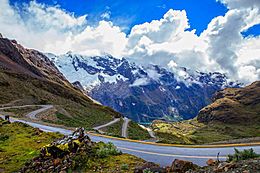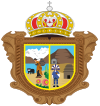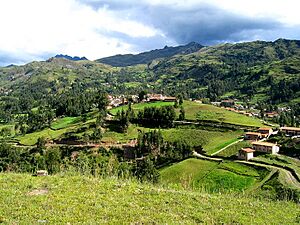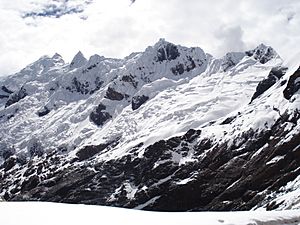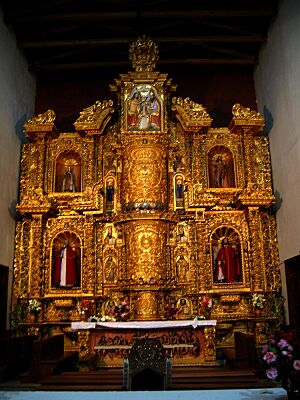Chacas facts for kids
Quick facts for kids
San Martín de Chacas
Chacas
|
|||
|---|---|---|---|
|
Town
|
|||
|
|||
| Nickname(s):
City of the stones
|
|||
| Motto(s):
Naturaleza, arte y fe para el mundo (Nature, art and faith for the world)
|
|||
| Country | |||
| Region | Ancash | ||
| Province | Asunción | ||
| District | Chacas | ||
| Area | |||
| • Total | 447.69 km2 (172.85 sq mi) | ||
| Elevation | 3.359 m (11.020 ft) | ||
| Website | www.munichacas.gob.pe | ||
San Martín de Chacas is a town in Peru, located high up in the Andes mountains. It's the main town of the Asunción Province in the Ancash Region. About 2,000 people live in the town itself, and around 5,000 live in the wider district. Chacas is located at 3,359 meters (about 11,020 feet) above sea level! The Chacas district covers a large area of about 447 square kilometers.
Chacas was founded in the 1570s. However, people have lived in this area for a very long time. There is evidence of human presence even before the ancient Chavin culture, found in caves and rock shelters. After the Chavin culture, the Huari people lived here.
The town of Chacas is special because it has kept its original Andean and Andalusian style of architecture. You'll see narrow streets and houses with beautiful carved wooden balconies and gates. These were made by skilled craftspeople from the Don Bosco workshops. A priest named Ugo de Censi and his group, Operation Mato Grosso, along with Italian residents, helped rebuild the Mama Ashu shrine and restore a baroque altarpiece from the 17th century. Today, artists in Chacas create amazing artworks for export. There's even a unique stained glass factory, the only one of its kind in South America!
During the yearly festival for the Virgin Mary, exciting events like bullfights and the "Race To Tapes" are held in the main square. You can also see traditional dances like the Mozo Danza and the Porter Dance, which is recognized as a National Cultural Heritage. The Provincial Museum has a large collection of ancient pre-Columbian artifacts.
Contents
What Does the Name Chacas Mean?
There are two main ideas about where the name Chacas comes from:
- It might come from the Quechua word chaka, which means "bridge." This idea suggests that all the roads leading into and out of the town always cross bridges.
- It could also come from the Quechua word chaga, meaning "watchtower." This is because Chacas is surrounded by many ancient watchtowers called pirushtus.
Exploring Chacas: Geography
Where is Chacas Located?
The Chacas district is on the eastern side of the Cordillera Blanca (White Mountains). It's also part of the area around the Huascarán National Park. The district has different altitude zones: Quechua, Suni (or Jalca), and Janca. Its elevation ranges from 2,800 meters (about 9,186 feet) up to 6,173 meters (about 20,253 feet) at the top of Copa mountain. The center of Chacas is in the Quechua zone, where crops like wheat are grown.
Chacas shares borders with several other provinces:
- To the northwest, west, and southwest: Carhuaz Province
- To the north: Acochaca District
- To the northeast and east: Carlos Fermín Fitzcarrald Province
- To the southeast: Huari Province
The Land Around Chacas
The town of Chacas sits on a plateau (a flat area of high ground). The land around the town is very rugged and mountainous. The highest peaks are Perlilla (5,586 m), Wakuy (4,702 m), and Copa (6,173 m).
Water Resources
Chacas has many rivers and streams that provide water for people and for farming. Two main rivers, the Gun River and the Chakapata River, flow through the district. They are fed by 35 smaller streams. When they join, they form the Aquchaka River.
Important streams used by towns for water and irrigation include Rayan (east), Camchas (west), and Juitush (south).
The district also has 32 lakes. One of them, Patarqucha, has been dammed to provide drinking water. Other major lakes include Libron, Cancaraca, Pagarisha, Wakuyqucha, and Ventanilla.
Chacas Weather
The Chacas area has many different microclimates. These change depending on the altitude and other factors. Because it's a high-altitude area close to the tropical zone, temperatures can change a lot in just 24 hours. For example, on a clear day in July, temperatures might be between 10°C and 30°C (50°F and 86°F). But at night, they can drop to -3°C to 10°C (27°F to 50°F).
A Look Back: History of Chacas
Early Beginnings
Scientists believe the first people to settle in this region were the Waris. They arrived from Central America, traveling through the jungle, and then spread across South America.
Chavin Culture's Influence
The ancient Chavín culture was very important in this area. It influenced the Wari people in the north, just like the Tiwanaku culture influenced the south. After the powerful Wari empire broke apart, different groups of people, sharing similar backgrounds and languages, formed their own kingdoms. One of these was the Conchucos kingdom, which included many tribes in the area where Chacas is today.
Recuay and Pashash Cultures
Between the years 100 and 1000 AD, the Pashash culture developed in the northern Sierra de Ancash. Later, the Recuay culture (also called Pashash-Recuay) grew from this. Even before these cultures, small farming towns with simple pottery existed in these places.
The Inca Period
From about 1000 to 1470 AD, different regional states formed. Chacas was one of the important areas within the Conchucos kingdom. This kingdom thrived until the Inca Empire took over.
The Incas ruled this area between 1460 and 1533. The kingdoms of Huaylas and Conchucos became part of the Inca Empire after a fierce invasion led by Inca Pachacuti's brother, General Qhapaq Yupanqui. However, the Inca rule wasn't fully established. Even though it lasted for 80 years, the Spanish arrived before the Inca way of life was completely adopted. This is why Inca traditions didn't take deep root in the Conchucos area. The many "pirushtus" (defensive structures on hills) show that different groups lived and fought each other before the Incas.
Colonial Times
The town of Chacas was founded in April 1572 by Spanish missionaries and officials. It was named San Martín I, who became the town's patron saint. The founding took place in the lands of a local leader named Francisco Tocto de Chagastunán.
The Chacas temple was built on top of an old and important sacred site. This was one of the native shrines (pirushtus) from before the Inca times, used to worship the "Piedra de Chacas" (Stone of Chacas) idol. The main square was laid out with streets forming a checkerboard pattern. The buildings around the square were built by the first local families. Spanish clergy and government officials settled near the temple, while the town hall, school, and prison were built in the plaza.
San José de Mushuqmarka: Founded in 1716, this was the largest mill in the area for 60 years. It was owned by Captain Juan Tafur, a miner who operated mines nearby. He also founded a religious charity (chaplaincy) in Mushuqmarka in 1718.

Peru's Independence
During Peru's fight for independence, many men from Chacas joined the armies fighting for freedom. One important person was the priest Tadeo Gómez Alvarado. He joined a group of fighters to rescue patriotic prisoners. His group successfully entered Huaraz on April 30, 1821.
Republican Period
In 1825, during the government of Simón Bolívar, the old religious areas of Conchucos became districts. This is how the district of Chacas was officially created as part of the Huari province. In 1837, Francisco Aráoz de La Madrid, an Argentine hero of Peru's independence, passed away in Chacas.
On January 2, 1857, the district of Chacas was officially recognized by law.
Mining became very important in the 1860s. There was a high demand for metals in Europe and America. This brought many foreign investors to the Ancash area. Business people from Italy, England, France, Germany, and Croatia started various activities, with mining being a major one. In 1875, large and modern mining companies like Pompey and El Vesubio were founded in Chacas. They mined gold, silver, lead, copper, and zinc from the high mountains.
The Work of Ugo de Censi
In 1976, an Italian missionary priest named Ugo de Censi came to Chacas. He founded Operation Mato Grosso, a group of young Italians who help people in need. Father de Censi noticed that some people in Chacas, like landowners and mine owners, were much richer than the rural population, who lived in extreme poverty. Many poor people were leaving their homes to find work in cities. Moved by this, Father de Censi started the Don Bosco Workshop School in 1978. This school was for the poorest children and orphans in the district.
Chacas in the 21st Century
Modern Connections
After two years of hard work, a modern road called AN-107 was completed in August 2013. This road includes the Punta Olímpica tunnel, which is the second-highest vehicle tunnel in the world! This amazing project cut the travel time to Huaraz from 7 hours down to just 3 hours.
A Top Tourism Village
In October 2023, Chacas received a special award! It was named one of the "Best Tourism Villages in the World" by the World Tourism Organization (UNWTO). This award recognized Chacas for its cultural and natural beauty, its efforts to preserve its heritage, and its focus on sustainable tourism.
What to See: Tourism
The local government of Asunción Province has a collection of about 400 ancient ceramic pieces, sculptures, and other artifacts. This is one of the largest collections in the Ancash region! The Chacas Archeology Museum displays about thirty of these pieces, thanks to help from Milan, Italy, the Chacas parish, and the local government. There are over 100 archaeological sites in the district, and 32 of them are officially recognized as Cultural Heritage sites.
Fun and Culture: Folklore
Traditional Dances
The province of Chacas has many different types of traditional dances. Here are some of them:
- Anti (Antiruna)
- Corpus Dance or Porter Dance (recognized as a National Cultural Heritage)
- Shaqsha
- Wari
- Paso Wankillas
- Palla
- Bold
- Atawallpa
- Pizarros
- Llallu
Celebrations
Mama Ashu Festival
The most important festival in Chacas is on August 15th. It's held in honor of "Mama Ashu," which is a special name for the Virgin of the Assumption.
See also
 In Spanish: Chacas para niños
In Spanish: Chacas para niños







